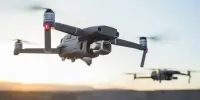Artificial vision systems are an important component of sensor technologies, with applications ranging from autonomous vehicles to monitoring devices and robotic assistants. Creating an artificial eye that captures the right quality and depth of information, on the other hand, has proven difficult, with many existing systems lacking a full 360-degree field of vision and being suited to either land or water rather than both.
Self-driving cars, object detection, crop monitoring, and smart cameras are just a few of the applications for artificial vision systems. Such vision is frequently inspired by biological organisms’ vision. Human and insect vision, for example, have inspired terrestrial artificial vision, whereas fish eyes have inspired aquatic artificial vision. While progress has been remarkable, current artificial visions have some limitations: they are not suitable for imaging both land and underwater environments and have a hemispherical (180°) field-of-view (FOV).
To overcome these issues, a group of researchers from Korea and USA, including Professor Young Min Song from Gwangju Institute of Science and Technology in Korea, have now designed a novel artificial vision system with an omnidirectional imaging ability, which can work in both aquatic and terrestrial environments. Their study was made available online and published in Nature Electronics.
Our vision system could pave the way for 360° omnidirectional cameras with applications in virtual or augmented reality or an all-weather vision for autonomous vehicles. Bio-inspired vision research frequently results in a previously unknown development.
Prof. Song
“Bio-inspired vision research frequently results in a previously unknown development. This, in turn, allows for a better understanding of nature and ensures that the imaging device developed is both structurally and functionally effective” Prof. Song explains his motivation for the study.
Fiddler crabs are unique in that they have an omnidirectional eye that allows them to see 360 degrees both underwater and on land. The eyes of the small creature are raised above their heads like a periscope and have flat corneas, allowing the crab to see around it without moving its body.

The inspiration for the system came from the fiddler crab (Uca arcuata), a semiterrestrial crab species with amphibious imaging ability and a 360° FOV. These remarkable features result from the ellipsoidal eye stalk of the fiddler crab’s compound eyes, enabling panoramic imaging, and flat corneas with a graded refractive index profile, allowing for amphibious imaging.
Accordingly, the researchers developed a vision system consisting of an array of flat micro-lenses with a graded refractive index profile that was integrated into a flexible comb-shaped silicon photodiode array and then mounted onto a spherical structure. The graded refractive index and the flat surface of the micro-lens were optimized to offset the defocusing effects due to changes in the external environment. Put simply, light rays traveling in different mediums (corresponding to different refractive indices) were made to focus at the same spot.
The team used optical simulations and imaging demonstrations in air and water to test the capabilities of their system. The device was immersed halfway in water for amphibious imaging. The images produced by the system were clear and free of distortions, much to their delight. The team also demonstrated that the system had a panoramic visual field in both air and water, measuring 300o horizontally and 160o vertically. The spherical mount was also only 2 cm in diameter, making the system small and portable.
Prof. Song speculates, “Our vision system could pave the way for 360° omnidirectional cameras with applications in virtual or augmented reality, or an all-weather vision for autonomous vehicles.”















